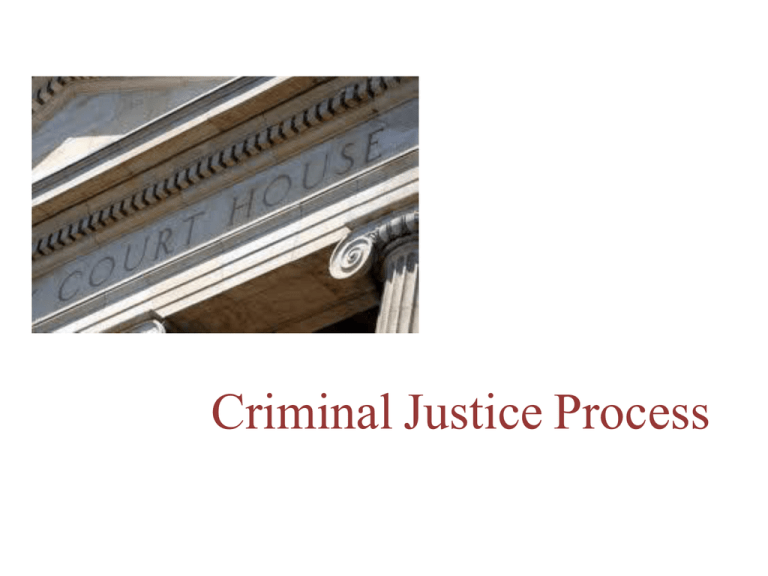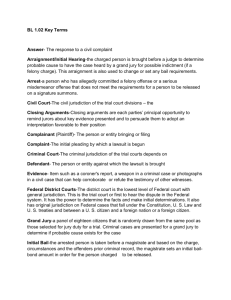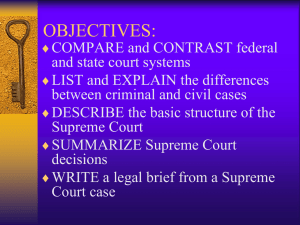
Criminal Justice Process
1. INVESTIGATION:
After a crime has been Discovered,
evidence is gathered and follow-up
investigations attempt to reconstruct
the sequence of activities leading up to and including the criminal
event. Efforts to identify suspects are initiated.
2. WARRANT: An arrest warrant issued by a judge provides the legal
basis for an apprehension of suspects by police.
3. ARREST: In an arrest, a person is taken into custody, limiting the
arrestee’s freedom. Arrest is a serious step in the process of justice.
During arrest and questioning, defendants are usually advised of their
constitutional rights, or Miranda Rights.
4. BOOKING: Booking is an administrative procedure where pictures,
fingerprints, and personal information are obtained.
5. FIRST APPEARANCE: Within hours of arrest
suspects must be brought before a magistrate (a judicial
officer) for an initial appearance. The judge will tell the
defendant of the charges against them, advise them of
their rights, and may provide the opportunity for bail.
6. PRELIMINARY HEARING : The prosecution must
produce evidence to show probable cause that the
defendant committed the crime. This step is sometimes
combined with the initial appearance. The next step
depends on if the crime is a misdemeanor or felony. If a
misdemeanor the judge will set a date for a trial. If a
felony the case will go before the grand jury. The grand
jury will decide if there is enough evidence to indict
(formally charge) the defendant.
THE INITIAL APPEARANCE: Must be held within 48 – 72 hours after
arrest in order to protect people from being put in jail and forgotten (habeas
corpus).
WRIT OF HABEA CORPUS: A writ that directs the person detaining a
prisoner to bring him or her before a judicial officer to determine the
lawfulness of the imprisonment.
7. INFORMATION: A formal, written accusation submitted to a court by
a prosecutor, alleging that a specified person has committed a specified
offense.
7a.INDICTMENT: A formal, written accusation submitted by the court by
a grand jury, alleging that a specified person has committed a specified
offense, usually a felony.
8. ARRAINGNMENT: The first appearance f the defendant before the
court that has the authority to conduct a trial. The accused stands before
a judge and hear the information, or indictment, against them as it is
read. Defendants are again notified of their rights and are asked to enter
a plea.
9. ADJUDICATION: A criminal trial may be held, or the defendant may
decide to enter a guilty plea. A criminal trial involves an adversarial
process that pits the prosecution against the defense. In most trials, a
jury hears the evidence and decides issues of guilt or innoncence, while
the judge ensures the
Fairness of the proceedings.
10. SENTENCING: After the person has been convicted it is up to the
judge to determine the punishment. Prior to sentencing, a sentencing
hearing is sometimes held in which attorneys for both sides can
present information to influence the judge’s decision.
11. CORRECTIONS: The corrections period begins following
sentencing. Corrections involves a variety of sentences that can be
imposed on a defendant. (Community Supervision, Community
Service, Jail Time, Prison Time, Treatment Programs).
12. REENTRY: Not everyone who has been convicted of a crime goes
to prison. Community Supervision (Probation) imposes requirements
or restrictions upon offenders. Offenders are required to check in with
a probation officer on a regular basis. After a defendant has served a
portion of his prison term he may be freed on parole. Like probation,
parole may come with obligations and requires the offender to check
in with a parole officer.
Absolute Certainty
Beyond a
Reasonable
Doubt
Criminal Jury Verdict
Non-Suggestiveness of
Identification
Clear and
Convincing
Civil Trial Decision
Preponderance
Take Case to a Jury
Arrest, Search,
Indictment,
Information
Stop, Frisk,
Question
Prima Facie
Probable Cause
Reasonable Suspicion
Mere Hunch
No Basis for Knowledge
Copyright © Texas Education Agency 2011. All rights reserved.
Images and other multimedia content used with permission.
7
Classifications of Crimes
• Class C Misdemeanor
– Fine up to $500 (ticket)
– Cannot be arrested
• Speeding or Open Container
• Class B Misdemeanor
– Up to 180 days in jail
– $2,000 fine
• Class A Misdemeanor
– Up to 2 years in jail
– $4,000 fine
8
Classifications of Crimes
State Jail Felony (SJF):
180 days to 2 years
$10,000 fine
3rd Degree:
2-10 years
$10,000 fine
2nd Degree:
2-20 years
$10,000 fine
1st Degree:
5-99 years
$10,000 fine
Capital:
Death
Life without Parole
Copyright © Texas Education Agency 2011. All9rights reserved.
Images and other multimedia content used with permission.
Fourth Amendment
• “The right of the people to be secure in
their persons, houses, papers, and effects,
against unreasonable searches and
seizures, shall not be violated, and no
Warrants shall issue, but upon probable
cause, supported by Oath or affirmation,
and particularly describing the place to be
searched, and the persons or things to be
seized.”
10
Fifth Amendment
•
•
•
•
•
Grand jury
Double jeopardy
Self-incrimination
Due process
Just compensation for government takings
11
Double Jeopardy
• Exceptions to Double Jeopardy
– Convicted and asks for a new trial
– Convicted and the case is overturned
– The case results in a hung jury
– Can be tried at both the state and federal levels
for the same crime
12
More On The 5th Amendment
• The Grand Jury indictment rule does not apply in a time
of war.
• You cannot be tried twice for the same offense.
• You cannot be forced to be a witness against yourself.
• You cannot be arrested, convicted, or executed without
due process of law.
• The government can seize your land but they have to
pay you just compensation. This law is referred to as
“Eminent Domain.”
Copyright © Texas Education Agency 2011. All rights reserved.
13
Images and other multimedia content used with permission.
Sixth Amendment
• Speedy and public trial
• Impartial jury
• Informed of the nature and cause
of the accusation
• Confrontation of witnesses
• Compulsory process of witnesses
• Right to an attorney
14
Eighth Amendment
• No excessive bail
• No excessive fines
• No cruel and unusual
punishment
15
History of the Federal Court System
• Article III of the US Constitution established a
federal court system
• Congress created Article III on Sept. 24, 1789
• Congress passed the Judiciary Act of 1789,
which established 13 courts, one for each of
the original states
16
Structure of the Federal Court System
• The structure of the federal court system
begins with the magistrate courts and ends
with the Supreme Court:
– Supreme Court
– Appellate Courts
– Trial Courts
– Magistrate Courts
17
Structure of the Federal Court System
(continued)
• Magistrate Courts
– Created by the Federal Magistrate’s Act of 1968
– Magistrates are appointed by a district court judge
• Full-time magistrates are appointed to an 8-year term
• Part-time magistrates are appointed to a 4-year term
18
Structure of the Federal Court System
(continued)
• Trial Courts
– Are also known as US district courts
– There are 94 US district courts covering the US
and its territories
– The judges are appointed by the US President
• Serve a life term
• Consent from Congress is required
19
Structure of the Federal Court System
(continued)
• Court of Appeals
– Are also known as Appeals Court, Appellate Court,
and Circuit Courts
– There are 12 US Regional Circuit Courts of Appeal and
one US Court of Appeals for the Federal Circuit and
approximately 165 federal courts of appeals judges
– The court does not conduct a jury trial but is made up
of a panel of judges, usually three
– The judges are appointed by the US President
• Confirmed by the Senate
• Serve a lifetime appointment
20
Structure of the Federal Court System
(continued)
• US Supreme Court
– Is the highest court in the US
– Consists of nine justices
– A decision of the Supreme Court is final and
cannot be overruled
– The judges are nominated and appointed by the
US President
• Confirmed by Senate
• Serve a lifetime appointment
21
History of the State Court System
• The Texas Supreme Court was established in 1836 after
the Texas Revolution
• In 1845 the Supreme Court was restructured, and in 1850
the offices of the Supreme Court were filled by elections
• In 1876, to relieve the case load of the Supreme Court,
the Court of Appeals was created to deal with criminal
cases; it was later renamed the Court of Criminal Appeals
• In 1980 the previously established courts, the Courts of
Civil Appeals, were renamed Courts of Appeals and were
designed to relieve the Court of Criminal Appeals’
caseload
22
Structure of the State Court System
• Began with the justice or municipal courts and
ended with the Texas Supreme Court or the
Court of Criminal Appeals:
– Texas Supreme Court or Court of Criminal Appeals
– Courts of appeals
– District courts
– County courts
– Justice courts or municipal courts
23
Jurisdiction of the State Courts (Texas)
• Justice Courts
– Limited jurisdiction
– Original jurisdiction in Class C misdemeanor
criminal cases that are punishable by fine only
– Civil matters not more than $10,000
– Evictions (Landlord/Tenant law)
24
Jurisdiction of the State Courts (Texas)
(continued)
• Municipal Courts
– Limited jurisdiction
– Misdemeanors with fines less than $200
– Exclusive original jurisdiction over municipal
ordinance violations
– Limited civil jurisdiction
25
Jurisdiction of the State Courts (Texas)
(continued)
• County Courts
– Limited jurisdiction
– Constitutional County Courts
• Have appellate jurisdiction over the justice courts,
municipal courts, and administrative hearings
• Preside over Class A and Class B Misdemeanors
• Original jurisdiction in civil cases from $200 to $10,000
• Concurrent jurisdiction with justice of the peace and
district courts in civil cases in which the amount in
controversy is small
26
Jurisdiction of the State Courts (Texas)
(continued)
• County Courts (continued)
– County Court at Law
• Created by Legislature to aid the single constitutional county
court
• Legal jurisdiction varies
• Original, appellate, and concurrent jurisdiction are the same
as Constitutional County Court
– Statutory Probate Courts
• Original and exclusive jurisdiction over their counties'
probate matters, guardianship cases, and mental health
commitments
• Legislature grants authority to certain county courts
27
Jurisdiction of the State Courts (Texas)
(continued)
• District Courts
– General and Special Jurisdiction
– Original jurisdiction
•
•
•
•
•
All felony criminal cases
Divorce cases
Title to land cases
Contested election cases
Civil matters of $200 or more
– Juvenile matters
28
Jurisdiction of the State Courts (Texas)
(continued)
• Courts of Appeals
– Intermediate appellate jurisdiction
– Both criminal and civil cases
• State of Texas Highest Appellate Courts
– Texas Supreme Court
• Final appellate jurisdiction in civil cases
• Final appellate jurisdiction in juvenile cases
– Texas Court of Criminal Appeals
• Final appellate jurisdiction in criminal cases
29
Types of Laws
• Criminal Law
• Civil Law
• Administrative Law
30
Sources of the Law
• Constitutions
• Statutes
• Case laws
• Administrative Regulations
31
Statutory Law
• Enacted by Federal or State Legislatures
• Found in Codes (Ex: Penal Code)
• Examples: murder, rape, robbery, and
terrorism.
32
Judicial Law/Case Law
Precedent or stare decisis (“let the decision
stand”)
• Court’s Interpretation of Statutory Law
• Appellate Court Decisions
• Can include rulings on
– Procedural matters
– Evidentiary hearings
33
Due Process
Due process is mentioned twice in the
Constitution.
• Fifth Amendment: “No person shall…be
deprived of life, liberty or property without
due process of law.”
• Fourteenth Amendment:“No state shall
deprive any person of life, liberty or property
without due process of law”
34
Criminal Law
Criminal courts exist to enforce the substantive
criminal law
– Two basic types of crimes
• Felonies
• Misdemeanors
35
Presumption of Innocence
• The “state” (prosecution) has the “burden” of
proving a defendant guilty of alleged crimes
• Defendants are not required to prove
themselves innocent
• Guilt must be “beyond a reasonable doubt”
• Civil cases have a “preponderance of the
evidence” requirement
36
Elements of a Crime
• Corpus delicti: the body or substance of a
crime, composed of two elements: the act and
the criminal agency producing it
• Actus reus: the guilty act
• Mens rea: guilty state of mind
37
Civil Law
• Tort: a private or civil wrong, in which the
defendant’s actions cause injury to the plaintiff or to
property
• Contract: a legally enforceable agreement between
two or more parties
• Property: the legal right to use or dispose of
particular things or subjects
• Inheritance: property received from a dead person,
either by effect of intestacy or a will
38
JURISPRUDENCE
• The philosophy of law
• The science and study of the law
39
WHAT IS LAW?
•
•
•
•
A body of rules of conduct
Prescribed by a legitimate authority
Form of a statute
Mandates certain forms of behaviors
40
RULE OF LAW
• Supremacy of law
– Standards of behavior are established by laws and
not by dictators or religious leaders
– No person is above the law
– Everyone is subject to the law
– Everyone can be held accountable in court for
their actions
41
LIMITATIONS OF THE LAW
• Legality: laws defining crimes and penalties
must be made public before being enforced
– Made public by publishing laws
– Puts the members of society on notice
42
LIMITATIONS OF THE LAW
• Ex post facto: “not after the fact”
• Persons cannot be punished for actions
committed before the law prohibiting the
behavior was passed
43
LIMITATIONS OF THE LAW
• Void for Vagueness: the definitions of laws
must be clear and reasonable, specifying
prohibited behaviors; otherwise, those laws
are illegal
• A law must say what it means and mean what
it says.
44
LIMITATIONS OF THE LAW
• Void for Overbreadth: laws are illegal if they
are stated so broadly as to prohibit legal
activities as well as the illegal behavior
• Go too far
45
LIMITATIONS OF THE LAW
• Due Process: the government must treat people
equally and fairly before the law.
• Substantive - limits the power of governments to
create crimes unless there is compelling,
substantial, public interest in regulating or
prohibiting the conduct
• Procedural Due Process – the requirement that
the government must follow established
procedures and treat defendants equally
46
FUNCTIONS OF LAWS
• Defines Crime
– any act that the government has declared to be an
offense against the public good, declared by
statute to be a crime, and which is prosecuted in a
criminal proceeding
47
FUNCTIONS OF LAWS
• Defines Criminal Acts
1.
mala in se - acts that are crimes because
they are inherently evil.
2.
mala prohibita- acts that are prohibited
because they are defined as crimes by law, not
because the act is harmful or inherently evil.
48








